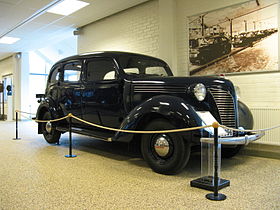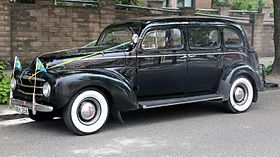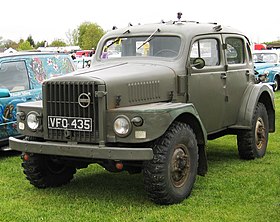Volvo PV800 Series
| Volvo PV800 Series | |
|---|---|
 |
|
| Overview | |
| Manufacturer | Volvo Cars |
| Production | 1938–1958 |
| Body and chassis | |
| Class | Taxicab |
| Body style | 4-door saloon |
| Layout | FR layout |
| Powertrain | |
| Engine | 3,670 cc (3.7 L) EC/ED I6 |
| Transmission | 3-speed manual |
| Dimensions | |
| Wheelbase | 3,250 mm (128.0 in) |
| Chronology | |
| Predecessor | Volvo TR670 Series |
| Volvo PV800-PV810 | |
|---|---|
 |
|
| Overview | |
| Also called | TPV |
| Production | 1938-1947 |
| Powertrain | |
| Engine | 3.6L EC I6 |
| Volvo PV821-PV824 | |
|---|---|
| Overview | |
| Production | 1947-1948 |
| Powertrain | |
| Engine | 3.6L ED I6 |
| Transmission | 3-speed column shift manual |
| Volvo PV831-PV834 | |
|---|---|
 |
|
| Overview | |
| Production | 1950-1958 |
| Powertrain | |
| Engine | 3.6L ED |
| Transmission | Volvo E9 |
| Volvo TP21 | |
|---|---|
 |
|
| Overview | |
| Also called |
|
| Production | 1953-1958 |
| Powertrain | |
| Engine | 3.6L ED I6 |
| Transmission | Volvo E9 |
The Volvo PV800 Series (affectionately known as Volvo-suggan or the Sow) was a taxicab manufactured by Volvo between 1938 and 1958. The Sow dominated the Swedish taxicab market during the 1940s and 1950s.
The PV801 (with a glass division between the front and rear seat) and the PV802 (without the glass division) were introduced in 1938 and superseded the TR670 Series. The chassis and body were all new but the side-valve engine was the same as in the older cars. The front end was also used on Volvo’s smallest lorry, the LV100 Series.
The PV802 could be used as a spare ambulance. After folding all seats on the car’s right side, a stretcher could be loaded through the bootlid. Volvo continued to build commercial chassis versions, which were often used as basis for proper ambulances.
During the Second World War Volvo built a four-wheel drive off-road vehicle, called Terrängpersonvagn m/43 (TPV), for the Swedish Armed Forces. The mechanical parts were based on Volvo’s smaller lorries and the body came from the Sow.
In 1947 the PV800 was succeeded by PV821 and PV822. The cars were updated with the slightly stronger ED engine and the column-mounted gear lever from the PV 60.
In the autumn of 1950 the model returned with a new front, similar to the front of the PV444 and the small lorry L340. The cars were renamed PV831 and PV832, respectively. In 1953 independent front suspension became optional. That same year, a civilian executive version, Disponent, saw the light of day.
...
Wikipedia
